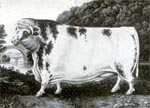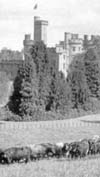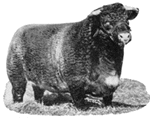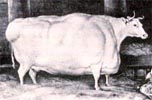Thanks to the American Shorthorn Association for the following information
The Shorthorn breed of cattle originated on the northeastern coast of England in the counties of Northcumberland, Durham, York and Lincoln. The first real development of the breed occurred in the valley of the Tees River about 1600. The large framed cattle that inhabited this fertile valley became known as Teeswater cattle.
The breed later spread to Scotland and then to America in 1783. When first brought to Virginia, the breed had attained the name Durham. It was the first improved breed to be imported here and the qualities that the animal possessed made it in great demand and its influence spread rapidly across America.
 Shorthorns were popular with America’s early settlers. They valued this breed for meat and milk and found Shorthorns a willing power for the wagon and plow as well. The breed followed pioneer wagons across the Great Plains and into the far west. By 1854, midwestern farmers had begun direct importations from Scotland, concentrating their efforts on Shorthorns strictly for beef production.
Shorthorns were popular with America’s early settlers. They valued this breed for meat and milk and found Shorthorns a willing power for the wagon and plow as well. The breed followed pioneer wagons across the Great Plains and into the far west. By 1854, midwestern farmers had begun direct importations from Scotland, concentrating their efforts on Shorthorns strictly for beef production.
Even in its early history, the breed was recognized because of its ability to adapt. It could be easily bred with the Spanish breed, Longhorns, brought in earlier by conquistadors. These early animals fit neatly in the time period to meet demand and needs during the early development of the beef cattle industry.
Although Shorthorns came first, midwesterners in 1870 discovered ‘natural hornless’ cattle occurred from time to time in horned herds. Thus, Polled Shorthorns were discovered and were the first major beef breed to be developed in the United States, having gained its origin in 1881 in Minnesota. Polled Shorthorns possess the same qualities for adaptability, mothering ability, reproductive performance, good disposition, feed conversion, longevity and popularity as their horned counterparts.
 In 1822, the first Herd Book record was established by Shorthorn breeders and was called the Coates Herd Book. The American Shorthorn Herd Book was the first to be published in this country for any breed and was started in 1846, with the formation of the American Shorthorn Association following 26 years later in 1872. Breeders from nine states formulated the organization, wishing to provide a service for its members and a way to record ancestry through the registration of Shorthorns. (continued on next page)
In 1822, the first Herd Book record was established by Shorthorn breeders and was called the Coates Herd Book. The American Shorthorn Herd Book was the first to be published in this country for any breed and was started in 1846, with the formation of the American Shorthorn Association following 26 years later in 1872. Breeders from nine states formulated the organization, wishing to provide a service for its members and a way to record ancestry through the registration of Shorthorns. (continued on next page)
The Shorthorn breed has one of the oldest American breed organizations in existence today. Shorthorns and Polled Shorthorns are registered in the same Herd Book. Over 45 other breeds of cattle show traces of Shorthorn Polled Shorthorn in their parentage, including Santa Gertrudis, Angus, Red Angus, Charolais, Gelbvieh, Beefmaster, Maine-Anjou and Milking Shorthorns.
View a photo of Shorthorn at the Worlds Fair, 1904

The American Shorthorn Association has an Appendix Registry (AR) program that has been ongoing since 1973. The intent behind the Appendix Registry Program has been to promote and verify the Shorthorn influence in the commercial ranks. This program has strengthened the American Shorthorn influence by increasing numbers and providing additional germ plasm through the use of related and non-related breeds. The American Shorthorn Association is the only British breed that has an ongoing Appendix Registry Program that documents the influence of related and non-related breeds in the breed registry.
In the fiscal year 1993-94, the American Shorthorn Association recorded 21,010 cattle in the breed registry. The current membership is in excess of 2,000 adult members, with nearly 3,000 juniors on the membership roll as well.
 Shorthorns/Polled Shorthorns are very adaptable to the changing needs of the beef cattle industry. Cattlemen are emphasizing size, efficiency and grading ability in their breeding programs and Shorthorns/Polled Shorthorns can provide that. In the feedlot, these cattle attain 1,000 to 1,200 pound weights at 12 months of age on limited amounts of feed and have no trouble producing carcasses that grade Choice.
Shorthorns/Polled Shorthorns are very adaptable to the changing needs of the beef cattle industry. Cattlemen are emphasizing size, efficiency and grading ability in their breeding programs and Shorthorns/Polled Shorthorns can provide that. In the feedlot, these cattle attain 1,000 to 1,200 pound weights at 12 months of age on limited amounts of feed and have no trouble producing carcasses that grade Choice.
View a photo of judging at the Perth show in 1946
The Shorthorn breed has been involved in Cycle IV of the Germ Plasm Evaluation (GPE) Program at the USDA Meat Animal Research Center (MARC) at Clay Center, Nebraska. The performance of the breed has astouned cattlemen throughout the United States and around the world.
 The breed has rated very high in calving ease (two assisted calvings in 181 births), post weaning growth, and has been the highest ranking beef breed ever tested at MARC for ability to produce USDA Choice quality grade carcasses at 14 to 15 months of age and do it consistently. The Shorthorn sired progeny have produced 79 per cent Choice compared to the next highest beef breed of 71 per cent. The breed has long been known for their maternal traits, milking ability and calving ease and now the breed is excelling in growth and carcass traits as well. These results have been confirmed in unbiased, feeding tests throughout the country.
The breed has rated very high in calving ease (two assisted calvings in 181 births), post weaning growth, and has been the highest ranking beef breed ever tested at MARC for ability to produce USDA Choice quality grade carcasses at 14 to 15 months of age and do it consistently. The Shorthorn sired progeny have produced 79 per cent Choice compared to the next highest beef breed of 71 per cent. The breed has long been known for their maternal traits, milking ability and calving ease and now the breed is excelling in growth and carcass traits as well. These results have been confirmed in unbiased, feeding tests throughout the country.